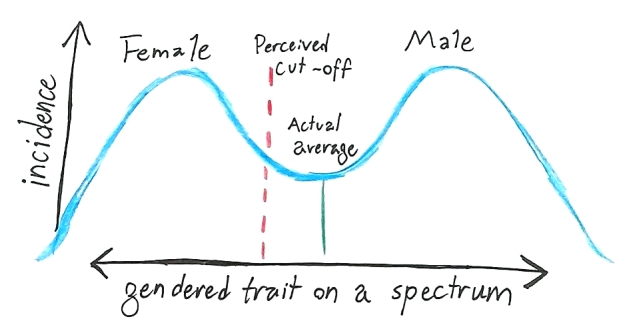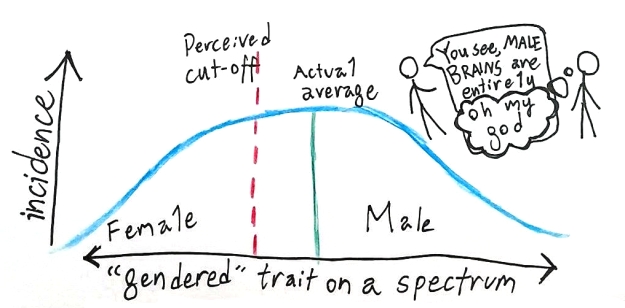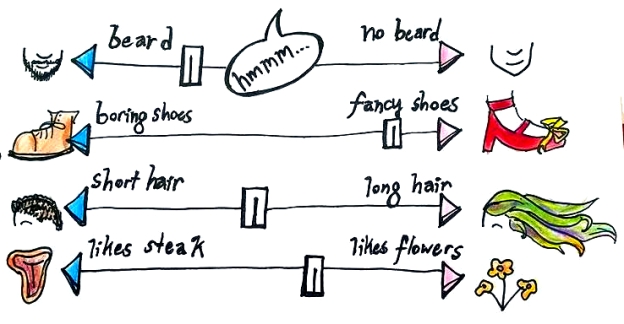[Content warning: Talking about ways that people automatically gender other people. If this is a tough topic for you, be careful. Also, a caveat that I’m talking descriptively, not prescriptively, about people’s unconscious and instant ways of determining gender, and not A) what they might actually think about someone’s gender, and certainly not B) what anyone’s gender actually is.
Nonetheless, if I got anything wildly or offensively inaccurate, please do let me know.]
When you try and figure out a stranger’s gender, you don’t just use one physical trait – you observe a variety of traits, mentally assign them all evidence weights, compare them to any prior beliefs you might have on the situation, and then – usually – your brain spits out a “man!” or “woman!” This is mostly unconscious and happens in under a second.
This is called “Bayesian reasoning” and it’s really cool that your brain does it automatically. Most people have some male, some female, and some neutral signals going on. ‘Long hair’ is usually a female signal, but if it’s paired with a strong jawline, heavy brows, and a low voice on someone who’s 6’5”, you’ll probably settle on ‘male’. Likewise, ‘wearing a suit’ is usually a pretty good male signal, but if the person is wearing makeup and is working at a hotel where everyone is wearing suits, you’re more likely to think ‘female’.
Then there are people with androgynous gender presentations – the people who you look at and your brain stumbles, or else does spit out an answer, but with doubt. (As a cis but not-particularly-gender-conforming woman, this is people around me all the time.) When people are read as ‘androgynous’, I think they’re doing three possible things:
- Strong male and female signals. Think a dress and a beard, or a high-pitched voice and being 6’4” and muscular, or wearing a suit and eyeliner. Genderfuck is an aesthetic that goes for this.
Left: Drag queen Conchita Wurst. Right: Game of Thrones character Brienne of Tarth.
2) No gender signals. Not giving gender cues, or trying to fall in the middle of any that exist on a spectrum. I think of this one as usually involving de-emphasized secondary sex characteristics – flat chest, no facial hair – which might also mean a youthful, neotenous look. Or maybe a voice or hips or height or whatever that’s sort of in the middle. Some (but not all!) androgynous models have something like this going on.
Left: Model Natacha S. Right: Zara’s Ungendered fashion line.
Fashion-wise, every now and then a company that rolls out a gender-neutral clothing line is criticized because all the clothing is baggy, formless, and vaguely masculine. (See comments below on why this may be.) I think these bland aesthetics are going for ‘No Signals’ – baggy clothing conceals secondary sex characteristics, the plain colors call to mind sort of a blank slate.
3) Signals for Something Else. For a trait that would normally signal gender, signal something else entirely. Long hair is for women, short hair is for men, but a green mohawk isn’t either of those. You might speak in a high-pitched voice, or a low-pitched voice, or in falsetto with an accent. Men wear pants, women wear dresses, but nobody wears this:
Pictured: I don’t know what these people are signalling, but it’s sure not a binary gender. [New York Fashion Week, 2015.]
What does this imply?
I’m not sure.
I expect that people who do No Signals get less shit from bigots (harassment, violence, weird looks) than people in the other two categories (Mixed Signals or Signaling Something Else.) I would imagine that bigots are more likely to figure that No Signals people are clearly a binary gender that they just can’t read, whereas Mixed Signals people are perceived as intentionally going against the grain.
This is unfortunate, because if you want to be read as androgynous, it’s way easier to just do Mixed Signals than to conceal secondary sex characteristics in order to do No Signals. (Especially if your secondary sex characteristics happen to be more pronounced.) Fortunately, society in general seems to be moving away from ‘instant gender reads are your real gender’, and towards ‘there are lots of different ways to do gender and gender presentation’.
Signaling Something Else people probably also get harassment and weird looks, but possibly more because they’re non-conforming in ways that don’t have to do with gender.
Male Bias in Gender Interpretation
Also! There is a known trend that suggests that people are more likely to read ambiguous traits as male than female. This is probably because ‘male’ is seen as ‘the default’, because culture. See: non-pet animals, objects other than cars and ships. This seems to have originally come from Kessler & McKenna (1978), and has held up in a few studies. I’m not sure if this rule is completely generalizable, but here’s a few things it might imply:
You may actually have to have more feminine traits than masculine ones to hit the Confusion Zone. For gender-associated traits that go on a spectrum – chest size, voice pitch, some metric of facial shape, etc., it might look like this:

Of course, there are also cases where people think a trait is associated with gender when, really, it’s not. That still might mean something like this:

(See also.)
One conclusion I’ve heard drawn from this: This explains why it’s often harder for trans women to get automatically gendered correctly, than for trans men. A trans woman has to conceal or remove a lot of ‘male’ traits to get read as female. Trans men, meanwhile, don’t have to go as far to hit ‘male’.
Even gender distribution world
Let’s say there are 100 gendered traits (wearing a dress or pants, long or short hair, facial hair or no facial hair, etc.) Now let’s imagine a population where everybody in this population has the “male” or “female” version of each trait assigned independently and randomly. If the male-bias principle generalizes, you’re likely to read more than half of these people are male.
Regional differences?
Gender presentation, and thus how you read gender, is deeply rooted in culture! If you see someone in garb from a culture you’re not familiar with, and you can’t tell their gender, it’s quite possible that they’re still doing intentional gender signals – just not in a way you can read.
Even for similar cultures, this might be different. When I was in England, people called me ‘sir’ all the time. This doesn’t happen often in Seattle. I have three theories for why:
- People in England have different gendered trait distributions for deciding gender. Maybe in England, just seeing ‘tall’ + ‘short hair’ + ‘wearing a collared shirt’ is enough to tip the scale to ‘man.’
- Where I was in England was just more culturally conservative than Seattle, and if I spent more time in, say, small towns in Southern or Midwest US, I’d also be ‘sir’d’ more.
- People in England are more likely to say ‘sir’ or ‘m’am’ at all. So if you were to ask a bunch of Seattle and England strangers if I was a man or a woman, the same percent would say ‘man’, but I wouldn’t notice in Seattle.
I think 2 or 3 are more likely, but 1 would be interesting as well.
Post Notes
- Ben Hoffman pointed out that this maps to classifications for people who don’t consistently vote for a major political party. Mixed Signals people are like swing voters or nonpartisan voters. No Signals people are political moderates or don’t vote at all. Signaling Something Else people are, like, anarchists. Or Pirate Party members.
- The Bayesian Evidence model of gender identification doesn’t only apply when the result is inconclusive – often your brain will, say, match someone as ‘man’, but also observe that they’re doing some non-masculine things.
(The first thing to consider in this case is that your brain may be wrong, and they may not actually be a man at all.)
- Anyways, what gender people are and what they signal to the world is more complex than an instantaneous read, and this is an important distinction. For instance, even when people look at me and think ‘woman’, they can tell that I’m not doing standard femininity either.
- If you’re trying to cultivate auto-gendering people less often, I suspect that training your subconscious to quickly separate whatever traits from gender would be useful. Finding efficient ways to do this is left as an exercise to the reader.
- It’s obviously possible to train your brain to look at someone and mentally assign them a gender other than the instantaneous response. I’ve also heard stories of people looking at people and automatically going “nonbinary”. I suspect that if you grew up in binary-gendered society, as so many of us tragically did, this is a thing you developed later in life. Maybe you learned this as a possible answer to the “confusion on gendering androgynous people” brain-state.







